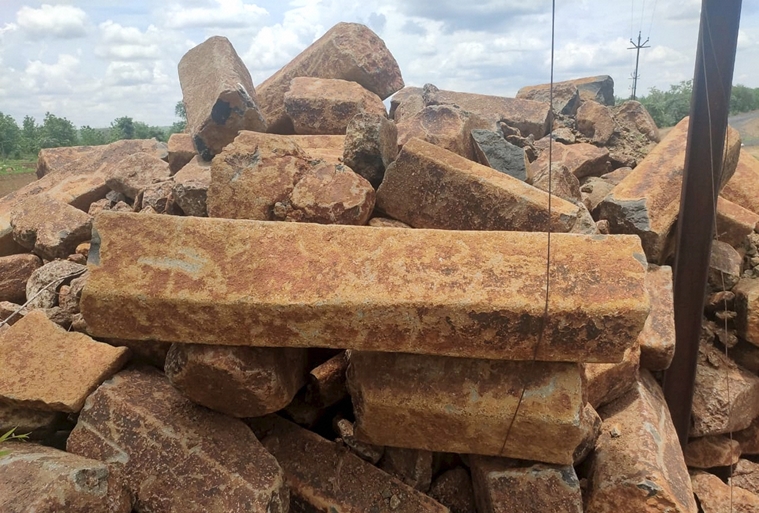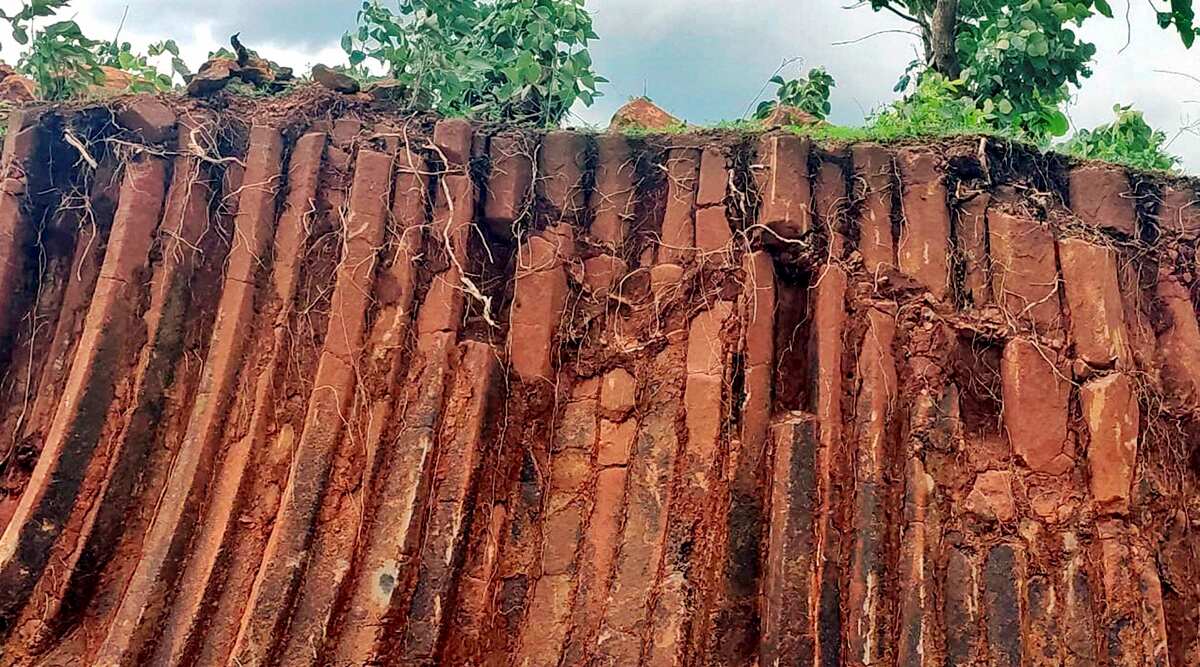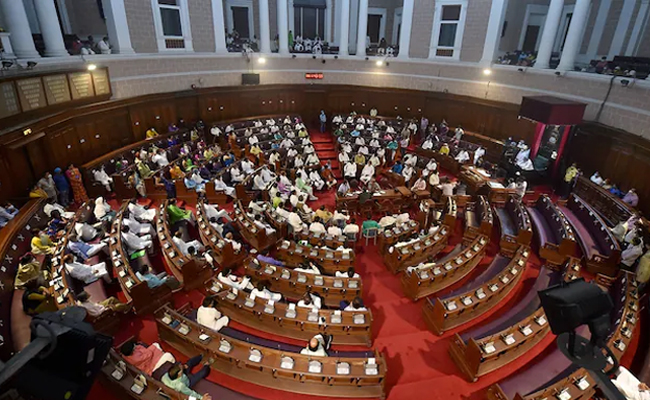Yavatmal, Jul 2: A basalt rock pillar, formed around 60 millions years ago from volcanic lava, has been discovered during road construction work at a village in Yavatmal district of Maharashtra, a leading geologist has said.
The rock formation was found last week at Shibla-Pardi village in Wani-Pandhakawda area of the district, he said.
Talking to PTI, environmentalist and geologist Prof Suresh Chopane said, It is a natural rock called columnar basalt formed from the lava of a massive volcanic eruption in Maharashtra 60 million years ago. The hexagon-shaped pillars were formed by cooling and contraction.
Chopane, a former member of the regional empowered committee of the Union Ministry of Environment, Forest and Climate Change, said the Wani area of Yavatmal district is geographically very ancient.
"In the same area, I had found 200-million-year, old stromatolites ((layered sedimentary formations) depicting many early life forms on earth of Neoprotezoic age and six-million-year-old conch shell fossils near Pandharkavada and Maregaon tehsil, he said.
Until 70 million years ago, there was an ocean on the now Vidarbha region of Maharashtra, he said.

In this undated photo, shows around 6 crore-year-old rare ‘Columnar basalt’ formed from the lava after the volcanic eruption was discovered in Shibla-Pardi village in Yavatmal district of Maharashtra. (PTI)
But 60 million years ago, during the late Cretaceous period, geographical events took place on the earth and from today's Western Ghats, hot lava flowed in the form fissures to Yavatmal district and central Vidarbha and up to Gujarat, known as Deccan trap, he said.
The volcano covered an area of five lakh square kms in central India. In Maharashtra, 80 per cent of the rock formations are basalt igneous rock, which comprise plagioclade feldspar, auguite and accessory mineral like magnetite, he said.
Chopane said that in India, St Mary's Island in Karnataka is famous as a tourist destination for such columnar basalt.
In Maharashtra, before Yavatmal, these rocks have been found in Mumbai, Kolhapur and Nanded. When a hot lava flows into a river and suddenly cools down, it shrinks and becomes hexagon-shaped, forming such stone pillars called columnar basalt, he said.
"These rocks are very important from the geographical point of view and the administration should protect stone pillars and the area found there," he said.
He also claimed that Yavatmal district was inhabited by giant dinosaur-like creatures and animals 60 million years ago. There were dense forests, but due to this huge volcanic eruption in Maharashtra, all the forests and living creatures turned to ashes.
Talking to PTI, spokesperson of the Geological Survey of India (GSI) in Nagpur, Rashtrapal Chavhan, said such rock formations are found commonly.
"It had been found at many places in India and it was exposed in Wani area of Yavatmal during road excavation work...This columnar basalt rock formation is about 64 million years old," he said.
Let the Truth be known. If you read VB and like VB, please be a VB Supporter and Help us deliver the Truth to one and all.
New Delhi: A significant political controversy has erupted following the Modi government's decision to rename the Mahatma Gandhi National Rural Employment Guarantee Act (MGNREGA), a move that has drawn sharp criticism from opposition parties. The row was further fueled by BJP MP Kangana Ranaut, who, while defending the name change, erroneously claimed that Mahatma Gandhi had made the devotional song "Raghupati Raghav Raja Ram" India’s national anthem.
The central government has rebranded the flagship rural employment scheme from MGNREGA to the "Viksit Bharat-Guarantee for Employment and Livelihood Mission," abbreviated as VB-G RAM G. The removal of Mahatma Gandhi's name from the scheme has been termed an insult to the Father of the Nation by the Congress and other opposition parties.
When questioned by the media outside Parliament regarding the opposition's allegations, Mandi MP Kangana Ranaut defended the government's decision by invoking Mahatma Gandhi's devotion to Lord Ram.
"How is naming it 'Ram Ji' an insult to Gandhi ji?" Ranaut asked. "Mahatma Gandhi made 'Raghupati Raghav Raja Ram' the national anthem to organize the entire country. Therefore, this is an insult to Mahatma Gandhi? The government is fulfilling his dream by giving it the name of Ram."
Ranaut's claim regarding the national anthem was immediately seized upon by the opposition. Congress leader Supriya Shrinate shared the video of Ranaut’s statement on social media, tweeting sarcastically, "Come on brother, today we learned a new national anthem! The BJP is full of such gems."
Social media users also trolled the MP for the factual error. One user quipped, "Kangana ji forgot to mention that Bapu made this the national anthem after the country got independence in 2014," while another commented that the party finds people who "don't use their brains while forwarding WhatsApp messages."
Beyond the social media mockery, senior Congress leaders criticised the renaming on ideological grounds. Former Rajasthan Chief Minister Ashok Gehlot took to X (formerly Twitter) to condemn the move.
"The biggest irony is that Mahatma Gandhi was a lifelong devotee of Lord Ram and said 'Hey Ram' in his last moments," Gehlot wrote. "Today, the central government is making a despicable attempt to sideline Gandhi ji under the guise of the same 'Ram' name (VB-G RAM G), which is highly condemnable."
मनरेगा का नाम बदलने की केंद्र सरकार की कवायद महात्मा गांधी के प्रति उनकी ओछी मानसिकता और असम्मान का प्रमाण है। सरकार पहले 'पूज्य बापू' के नाम का शिगूफा छोड़ती है और फजीहत होने पर अब 'विकसित भारत-गारंटी फॉर रोजगार एंड आजीविका मिशन (VB-G RAM G)' जैसा नाम थोपना चाहती है। बार-बार नाम…
— Ashok Gehlot (@ashokgehlot51) December 15, 2025
गांधी जी ने ‘रघुपति राघव राजा राम’ को लेकर नेशनल एंथम बनाया था
— Supriya Shrinate (@SupriyaShrinate) December 16, 2025
BJP MP कंगना रनौत
चलो भाई आज नया नेशनल एंथम भी पता चला है!
BJP में एक से एक शिरोमणि भरे पड़े हैं 😂🤣 pic.twitter.com/9DvyV5xLb1





